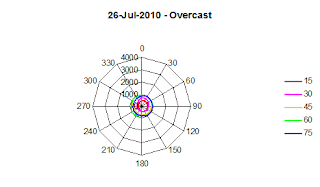This was quick-and-simple study to look at the distribution of solar irradiance under a cloud sky. The intention was to get some insight into the mounting of solar panels. Under a clear sky, the greatest output is obtained by pointing them at the Sun. For fixed mountings the optimum is facing south at an angle to the ground close to the latitude of the equipment. This may not be the case under a cloud sky where the direct beam irradiance is attenuated and a higher proportion of the total is diffuse from the hemisphere of the sky.
The equipment was constructed from materials to hand which included a length of waste pipe, part of a broken bed and a roll of packing tape. The main component was a light dependent resistor mounted at the base of a 300 mm length of white waste pipe whose translucence was reduced with a wrapping of parcel tape. The photo shows it in position sitting on top of a dust bin.
Operation consisted of setting the altitude to 15, 30, 45, 60 or 75 degrees, then rotating the instrument from 0 to 330 degrees in 30 degree increments and recording the resistance of the light dependent resistor.
The light dependent resistor has typical resistance of 20k at 100 lux. A simple calibration gave the relationship between resistance an luminescence of:
The results should be treated as relative irradiance which are consistent for the experiment, but are unlikely to represent accurate absolute values.
Overcast Sky - 26-Jul-2010 15:00: The irradiance increased slightly with altitude, but was relatively constant with azimuth. The cloud was thick and low, there was a small break to the northeast, hence the higher irradiance in that direction:
The conclusion drawn from this observation is that irradiance from an overcast sky is more or less uniformly distributed around the sky, albeit at a level much attenuated from that expected under clear sky conditions.
Broken Cloud - 27-Jul-2010 14:00: The early afternoon sky consisted of broken cloud, with the sun
occasionally visible through the cloud. Compared to the overcast sky the day before, there was significantly greater irradiance in the part of the sky in which the Sun was located.
Typically, in our part of the world, cloud described as broken, is a discrete layer and can sometimes have similar appearance to an overcast sky with only occasional glimpses of the blue sky above. This was the case on the day these readings were taken. There is an increase in irradiance in the direction of the Sun, but a significant amount of irradiance is coming from the sky as a whole.
Few Clouds - 28-Jul-2010 11:30: As so often happens when there are a few clouds in the sky, there was some fluctuation in the readings. The maximum irradiance was to the south east at an elevation of 45 to 60 degrees.
The irradiance under a sky with a few clouds is similar to that of a clear sky with exception that there may be short periods of attenuation.
Clear Sky - 16-Aug-2010 15:00 - The irradiance is clearly coming from the sun's disk:
Under a clear sky the maximum irradiance received by a device is when it is pointing directly at the Sun. In this case the maximum irradiance was around 230 degrees at an altitude of 45 degrees which is close to the altitude and azimuth predicted by Sun-Earth geometry.








No comments:
Post a Comment